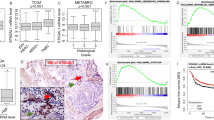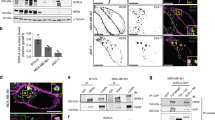Abstract
Human plasma membrane-associated sialidase (NEU3), a key enzyme for ganglioside degradation, is markedly upregulated in human cancers, leading to apoptosis suppression. To define molecular mechanisms and the possible target for NEU3, its encoding gene was silenced by small interference RNA (siRNA) or overexpressed in human cells. NEU3 siRNA-induced apoptosis with no special stimuli in HeLa cells, accompanied with decreased Bcl-xL and increased mda7 and GM3 synthase mRNA levels, whereas overexpression resulted in the opposite. Carcinoma HT-29 and MCF-7 cells appeared to be similarly affected, but normal cell lines demonstrated no significant changes. NEU3 siRNA was found to inhibit and NEU3 overexpression to stimulate Ras activation with consequent influence on extracellular signal-regulated kinases and Akt. Ras activation by NEU3 was abrogated by PP2 (src inhibitor) or AG1478 (epidermal growth factor receptor (EGFR) inhibitor), and NEU3 actually enhanced EGF-stimulated tyrosine-phosphorylation of EGFR, suggesting that the upstream targets might be tyrosine kinases including src and EGFR, and the subsequent stimulation of Ras cascade leads to the inhibition of cell apoptosis. Glycolipid changes observed seemed to be one of the causes of the cell effects. NEU3 may thus be an essential gene for cancer cell survival and siRNAs targeting this protein could have utility for gene-based therapy of human cancers.
This is a preview of subscription content, access via your institution
Access options
Subscribe to this journal
Receive 50 print issues and online access
$259.00 per year
only $5.18 per issue
Buy this article
- Purchase on Springer Link
- Instant access to full article PDF
Prices may be subject to local taxes which are calculated during checkout






Similar content being viewed by others
Abbreviations
- Gb3:
-
globotriaosylceramide
- LacCer:
-
lactosylceramide
- mda 7:
-
melanoma differentiation associated gene-7
References
Adjei AA . (2001). Blocking oncogenic ras signaling for cancer therapy. J Natl Cancer Inst 93: 1062–1074.
Allan LA, Morrice N, Brady S, Magee G, Pathak S, Clarke PR . (2003). Inhibition of caspase-9 through phosphorylation at Thr 125 by ERK MAPK. Nat Cell Biol 5: 647–654.
Biscardi JS, Maa MC, Tice DA, Cox ME, Leu TH, Parsons SJ . (1999). c-Src-mediated phosphorylation of the epidermal growth factor receptor on Tyr845 and Tyr1101 is associated with modulation of receptor function. J Biol Chem 274: 8335–8343.
Bremer EG, Schlessinger J, Hakomori S . (1986). Ganglioside-mediated modulation of cell growth. Specific effects of GM3 on tyrosine phosphorylation of the epidermal growth factor receptor. J Biol Chem 261: 2434–2440.
Cox AD, Der CJ . (2003). The dark side of Ras: regulation of apoptosis. Oncogene 22: 8999–9006.
Da Silva JS, Hasegawa T, Miyagi T, Dotti CJ, Avad-Rodriguez J . (2005). A symmetric membrane ganglioside sialidase activity specifies axonal fate. Nat Neurosci 8: 606–615.
Dennis JW, Granovsky M, Warren CE . (1999). Glycoprotein glycosylation and cancer progression. Biochim Biophys Acta 1473: 21–34.
Dent P, Yacoub A, Grant S, Curiel DT, Fisher PB . (2005). MDA-7/IL-24 regulates proliferation, invasion and tumor cell radiosensitivity: a new cancer therapy? J Cell Biochem 95: 712–719.
Hakomori S . (1996). Tumor malignancy defined by aberrant glycosylation and sphingo(glyco)lipid metabolism. Cancer Res 56: 5018–5309.
Hakomori S . (2002). Glycosylation defining cancer malignancy: new wine in an old bottle. Proc Natl Acad Sci USA 99: 10231–10233.
Hasegawa TK, Wada T, Takeda A, Itoyama Y, Miyagi T . (2000). Molecular cloning of mouse ganglioside sialidase and its increased expression in Neuro2a cell differentiation. J Biol Chem 275: 8007–8015.
Holmstrom TH, Tran SEF, Johnson VL, Ahn NG, Chow SC, Eriksson JE . (1999). Inhibition of mitogen-activated kinase signaling sensitizes HeLa cells to Fas receptor-mediated apoptosis. Mol Cell Biol 19: 5991–6002.
Kakugawa Y, Wada T, Yamaguchi K, Yamanami H, Ouchi K, Sato I et al. (2002). Up-regulation of plasma membrane-associated ganglioside sialidase (Neu 3) in human colon cancer and its involvement in apoptosis suppression. Proc Natl Acad Sci USA 99: 10718–10723.
Kato K, Shiga K, Yamaguchi K, Hata K, Kobayashi T, Miyazaki K et al. (2005). Plasma membrane-associated sialidase (NEU3) differentially regulates integrin-mediated cell proliferation through laminin-and fibronectin-derived signaling. Biochem J 394: 647–656.
Kim YJ, Varki A . (1997). Perspectives on the significance of altered glycosylation of glycoproteins in cancer. Glycoconj J 14: 557–569.
Li K . (1992). Determination of sialic acids in human serum by reversed-phase liquid chromatography with fluorimatric detection. J Chromatogr 579: 209–213.
Macala IJ, Yu RK, Ando S . (1983). Analysis of brain lipids by high performance thin-layer chromatography and densitometry. J Lipid Res 25: 1243–1250.
Mangeney M, Richard Y, Coulaud D, Tursz T, Wiels J . (1991). CD77: an antigen of germinal center B cells entering apoptosis. Eur J Immunol 21: 1131–1140.
Miura Y, Kainuma M, Jiang H, Velasco H, Vogt PK, Hakomori S . (2004). Reversion of the Jun-induced oncogenic phenotype by enhanced synthesis of sialosyllactosylceramide (GM3 ganglioside). Proc Natl Acad Sci USA 101: 16204–16209.
Miyagi T, Kato K, Ueno S, Wada T . (2004). Aberrant expression of sialidase in cancer. Trends Glycosci Glycotech 16: 371–381.
Miyagi T, Wada T, Iwamatsu A, Hata K, Yoshikawa Y, Tokuyama S et al. (1999). Molecular cloning and characterization of plasma membrane-associated sialidase specific for gangliosides. J Biol Chem 274: 5004–5011.
Miyagi T, Wada T, Yamaguchi K, Hata K . (2004). Sialidase and malignancy. Glycoconjugate J 20: 189–198.
Monti E, Bassi MT, Papini N, Riboni M, Manzoni M, Venerando B et al. (2000). Identification and expression of NEU3, a novel human sialidase associated to the plasma membrane. Biochem J 349: 343–351.
Monti E, Preti A, Venerando B, Borsani G . (2002). Recent development in mammalian sialidase molecular biology. Neurochem Res 27: 649–663.
Sasaki A, Hata K, Suzuki S, Sawada M, Wada T, Yamaguchi K et al. (2003). Overexpression of plasma membrane-associated sialidase attenuates insulin signaling in transgenic mice. J Biol Chem 278: 27896–27902.
Sohn H, Kim YS, Kim HT, Kim CH, Cho EW, Kang HY et al. (2006). Ganglioside GM3 is involved in neuronal cell death. FASEB J 20: 1248–1250.
Testa JR, Bellacosa A . (2001). AKT plays a central role in tumorigenesis. Proc Natl Acad Sci USA 98: 10983–10985.
Tran SEF, Holmstrom TH, Ahonen M, Kahari V-M, Eriksson JE . (2001). MAPK/ERK overrides the apoptotic signaling from Fas, TNF, and TRAIL receptor. J Biol Chem 276: 16484–16490.
Ueno S, Saito S, Wada T, Yamaguchi K, Satoh M, Arai Y et al. (2006). Plasma membrane-associated sialidase is up-regulated in renal cell carcinoma and promotes the interleukin-6 -induced apoptosis suppression and cell motility. J Biol Chem 281: 7756–7764.
Valaperta R, Chigorno V, Basso L, Prinetti A, Bresciani R, Preti A et al. (2006). Plasma membrane production of ceramide from ganglioside GM3 in human fibroblasts. FASEB J 20: 1227–1229.
Wada T, Yoshikawa Y, Tokuyama S, Kuwabara M, Akita H, Miyagi T . (1999). Cloning, expression and chromosomal mapping of a human ganglioside sialidase. Biochem Biophys Res Commun 261: 21–27.
Wang XO, Sun P, Paller AS . (2003). Ganglioside GM3 blocks the activation of epidermal growth factor receptor induced by integrin at specific tyrosine sites. J Biol Chem 278: 48770–48778.
Wang Y, Yamaguchi K, Wada T, Hata K, Zhao X, Fujimoto T et al. (2002). Association of ganglioside-specific sialidase, neu 3, with caveolin in membrane microdomains. J Biol Chem 277: 26252–26259.
Watanabe R, Ohyama C, Aoki H, Takahashi T, Satoh M, Saito S et al. (2002). Ganglioside GM3 overexpression induces apoptosis and reduces malignant potential in murine bladder cancer. Cancer Res 62: 3850–3854.
Yamaguchi T, Hata K, Koseki K, Shiozaki K, Akita H, Wada T et al. (2005). Evidence for mitochondrial localization of a novel human sialidase (NEU4). Biochem J 390: 85–93.
Acknowledgements
This study was supported in part by Grants-in Aid from the Mitsubishi Foundation, and by Grants-in Aid for Scientific Research on Priority Areas Cancer from the Ministry of Education, Culture, Sports, Science and Technology of Japan.
Author information
Authors and Affiliations
Corresponding author
Additional information
Supplementary Information accompanies the paper on the Oncogene website (http://www.nature.com/onc).
Supplementary information
Rights and permissions
About this article
Cite this article
Wada, T., Hata, K., Yamaguchi, K. et al. A crucial role of plasma membrane-associated sialidase in the survival of human cancer cells. Oncogene 26, 2483–2490 (2007). https://doi.org/10.1038/sj.onc.1210341
Received:
Revised:
Accepted:
Published:
Issue Date:
DOI: https://doi.org/10.1038/sj.onc.1210341
Keywords
This article is cited by
-
Role of glycosyltransferases in carcinogenesis; growth factor signaling and EMT/MET programs
Glycoconjugate Journal (2022)
-
Sialidase NEU3 and its pathological significance
Glycoconjugate Journal (2022)
-
The sialidase inhibitor 2,3-dehydro-2-deoxy-N-acetylneuraminic acid is a glucose-dependent potentiator of insulin secretion
Scientific Reports (2020)
-
Human Sialidase Neu3 is S-Acylated and Behaves Like an Integral Membrane Protein
Scientific Reports (2017)



